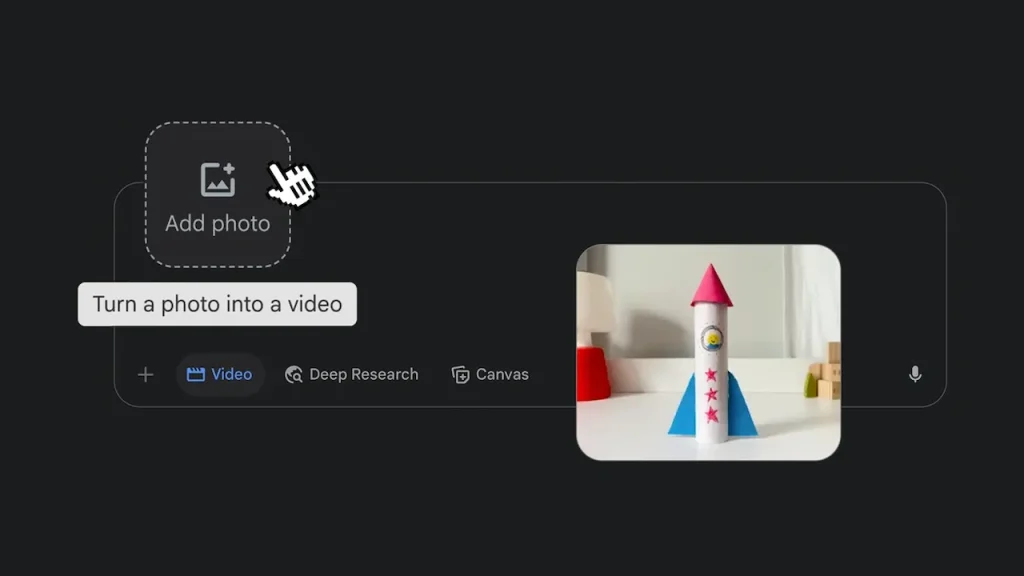Google today enhanced its Veo 3 AI model with a new image-to-video capability, allowing users to transform a single photo into an eight-second video clip with sound. The feature is now rolling out to subscribers of the company’s AI Pro and AI Ultra plans through the Gemini app.
Users can now upload a static image and, with a descriptive text prompt, animate it into a short, dynamic video. This update comes as Google reports impressive early adoption for Veo 3, with users creating over 40 million videos in just seven weeks.
The move is a key part of Google’s strategy to add tangible value to its recently simplified subscription tiers. It follows the global launch of Veo 3’s text-to-video function last week, solidifying the push to make advanced generative AI tools a daily resource.
From Still Image to Moving Picture
The core technology, Veo 3, represents a significant technical leap. Its ability to generate synchronized audio, including dialogue and ambient effects, is a key differentiator. Google DeepMind CEO Demis Hassabis declared that with this model, “we’re emerging from the silent era of video generation.”
This addresses a major hurdle in making AI-generated video feel complete right out of the box. Eli Collins, a Google DeepMind VP, highlighted the model’s sophistication, noting that “Veo 3 excels from text and image prompting to real-world physics and accurate lip syncing.” This focus on physics and lip-syncing is crucial for believable content.
The new image-to-video workflow is designed for simplicity. Inside the Gemini app, users select the “Videos” option, upload a photo, and then provide text instructions for the desired animation and accompanying audio effects.
These capabilities are also available in Flow, Google’s dedicated AI filmmaking tool. Flow integrates Veo for video, Imagen for image assets, and Gemini for natural language prompting, creating a comprehensive suite for advanced creative projects.
Watermarks and a Commitment to Safety
In a direct response to industry-wide concerns about deepfakes and misinformation, Google is embedding its SynthID watermarking technology into all Veo 3 outputs. This is a non-negotiable part of the generation process for all users.
Every generated video includes two layers of identification: a visible “Veo” watermark for immediate recognition and an invisible SynthID digital signature that is designed to be robust against common modifications like cropping or compression.
This dual approach is central to Google’s public commitment to responsible AI development. The company aims to provide transparency and ensure that AI-generated content can be clearly identified, a crucial step as these tools become more powerful.
However, the solution is not foolproof. An independent study from the University of Maryland found that watermarks can be vulnerable to manipulation. The researchers concluded, “watermarks offer value in transparency efforts, but they do not provide absolute security against AI-generated content manipulation,” highlighting the ongoing technological arms race between generation and detection.
A Clearer Subscription Strategy
This feature rollout underscores Google’s revamped AI monetization strategy, which it clarified in May by retiring confusing brand names like “Gemini Advanced” and “AI Premium”. The overhaul was designed to end long-standing brand confusion and create a clearer value proposition.
The $19.99/month AI Pro plan is positioned as the mainstream offering. It provides users with 2 TB of storage, the Gemini 2.5 Pro model, and 1,000 monthly AI credits, which Google says provides “ample room for creative exploration”.
In stark contrast, the $249.99/month AI Ultra plan targets “high-volume creators and small studios.” It bundles 30 TB of storage, a YouTube Premium subscription, and a massive 12,500 monthly credits for intensive use.
Josh Woodward, head of the Gemini app, framed the premium tier as an exclusive offering, stating that you can think of the Ultra plan as your “VIP pass for Google AI.” This is justified with early access to experimental tools like the Project Mariner AI agent.
The strategy also involved a significant pivot for Pro users. The move to three free daily Veo 3 generations was a shift from a limited one-time trial, turning the plan into a sustained creative resource rather than a simple demo.

